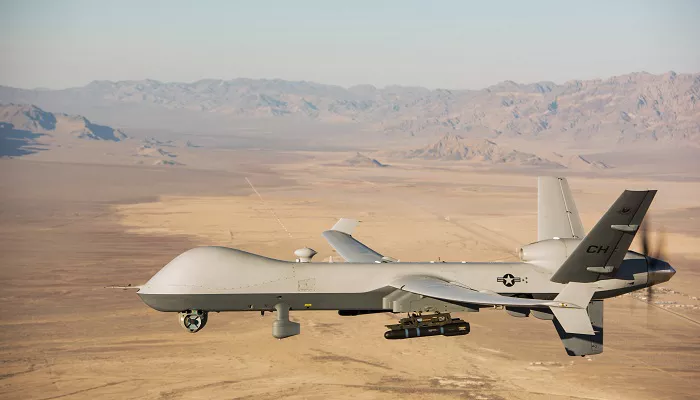The MQ-9 Reaper is a powerful unmanned aerial vehicle (UAV) developed by General Atomics Aeronautical Systems. It is designed for long-endurance, high-altitude surveillance, and precision strike missions. The MQ-9 is widely used by the United States Air Force and other allied nations. Its advanced capabilities make it a critical asset in modern military operations.
Speed and Performance
The MQ-9 Reaper is known for its impressive speed and performance. It has a maximum airspeed of approximately 300 mph (482 km/h) and a cruise speed around 230 mph (370 km/h). This allows it to quickly reach operational areas and maintain a persistent presence over targets.
In addition to its speed, the MQ-9 can operate at altitudes up to 50,000 feet (15,240 meters), providing a broad surveillance range and the ability to stay above most weather systems and threats.
Design and Specifications
The MQ-9 Reaper’s design emphasizes endurance and payload capacity. Key specifications include:
- Wingspan: 66 feet (20 meters)
- Length: 36 feet (11 meters)
- Height: 12.5 feet (3.8 meters)
- Maximum Takeoff Weight: 10,500 pounds (4,760 kg)
- Fuel Capacity: 4,000 pounds (602 gallons)
- Endurance: Up to 27 hours
- Range: 1,150 miles (1,000 nautical miles)
These features enable the MQ-9 to conduct extended missions without the need for frequent refueling or maintenance.
Advanced Avionics and Sensor Suite
The MQ-9 Reaper is equipped with sophisticated avionics and sensors that enhance its intelligence, surveillance, reconnaissance (ISR), and strike capabilities:
- AN/DAS-1 MTS-B Multi-Spectral Targeting System: Provides high-resolution imagery and accurate target identification using infrared, color/monochrome daylight TV, image-intensified TV, laser rangefinder/designator, and laser illuminator.
- Synthetic Aperture Radar (SAR): Delivers detailed ground imagery regardless of weather conditions and facilitates moving target indication (MTI).
- Signals Intelligence (SIGINT): Intercepts and analyzes electronic signals from adversaries, enhancing situational awareness and targeting precision.
Armament and Payload
The MQ-9 Reaper can carry a variety of weapons and equipment to fulfill its mission requirements:
- AGM-114 Hellfire Missiles: Effective against armored vehicles and personnel.
- GBU-12 Paveway II and GBU-38 Joint Direct Attack Munitions (JDAM): Precision-guided bombs for targeting structures and fortified positions.
- Payload Capacity: Up to 3,750 pounds (1,701 kilograms), allowing for a combination of weapons and sensors.
This versatility enables the MQ-9 to engage a wide range of targets while providing real-time intelligence to commanders.
Operational History
Since its introduction in 2007, the MQ-9 Reaper has been deployed in various conflict zones, including Afghanistan, Iraq, Syria, and Yemen. It has proven effective in both ISR and strike missions, contributing to the success of numerous military operations.
For example, the MQ-9 has been used to monitor insurgent activities, support ground troops, and conduct precision strikes against high-value targets. Its ability to loiter over areas for extended periods provides continuous coverage and rapid response capabilities.
Global Operators
The MQ-9 Reaper is operated by several countries around the world, including:
- United States: Primary user with extensive deployment across various theaters.
- United Kingdom: Operates the MQ-9 for surveillance and strike missions.
- France: Utilizes the MQ-9 for intelligence gathering and counterterrorism efforts.
- Italy: Employs the MQ-9 for both military and homeland security operations.
- Spain: Recently integrated the MQ-9 into its air force for ISR missions.
These nations leverage the MQ-9’s capabilities to enhance their defense and security operations.
Comparison with Other UAVs
Compared to other UAVs, the MQ-9 Reaper stands out due to its combination of speed, endurance, payload capacity, and advanced sensors. While smaller drones may offer stealth or agility, the MQ-9 provides a balanced platform capable of performing multiple roles effectively.
For instance, the MQ-1 Predator, its predecessor, has a lower speed and payload capacity, making the MQ-9 a significant upgrade in terms of operational capabilities.
Challenges and Vulnerabilities
Despite its strengths, the MQ-9 Reaper faces certain challenges and vulnerabilities:
- Air Defense Threats: The MQ-9 can be targeted by surface-to-air missiles and other air defense systems, as demonstrated by incidents where adversaries have claimed to shoot down the drone.
- Electronic Warfare: The reliance on satellite communications makes the MQ-9 susceptible to jamming and cyber attacks, potentially disrupting its operations.
- Cost: With a unit cost of approximately $64.2 million (including four aircraft, sensors, ground control stations, and communications), the MQ-9 represents a significant investment, and losses can be financially impactful.
Addressing these challenges is crucial for maintaining the effectiveness and survivability of the MQ-9 in contested environments.
Conclusion
The MQ-9 Reaper’s speed, combined with its endurance and advanced capabilities, makes it a formidable tool in modern warfare. Its ability to operate efficiently at various speeds allows it to perform a wide range of missions, from surveillance to precision strikes. As military technology continues to evolve, the MQ-9 Reaper sets a benchmark for the performance of unmanned aerial vehicles.


